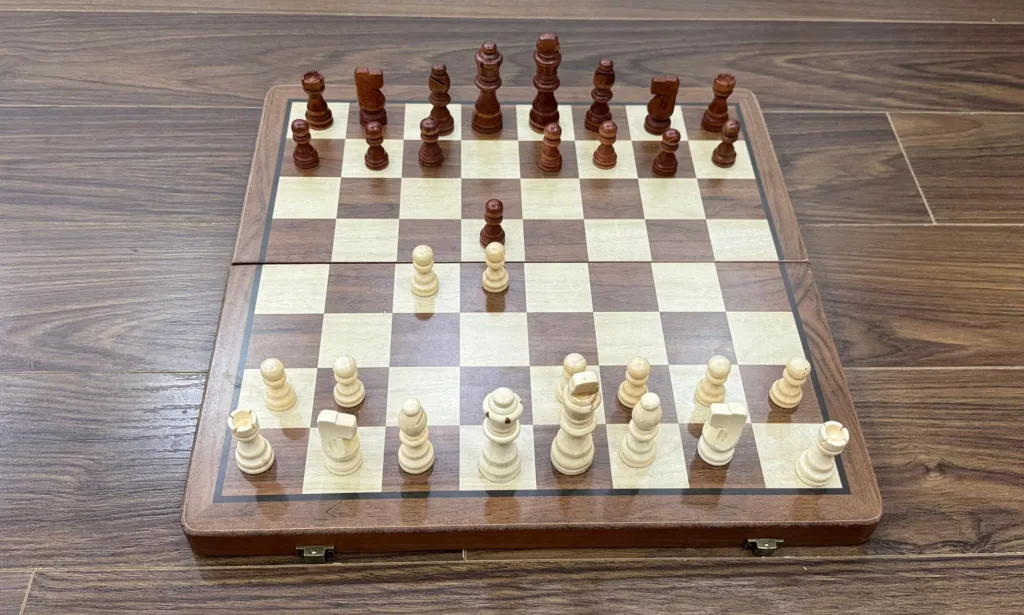The Queen’s Gambit is one of the oldest and most respected openings in chess. It isn’t just a popular Netflix title, it’s a pillar of chess strategy.
It begins:
- d4 d5
- c4
White offers a pawn, not as a true sacrifice, but as bait. The goal is to provoke Black into giving up the central tension. If Black takes the pawn, he risks falling behind in development and surrendering central control.
- Opening Statements
- What Should Black Do After 2. c4?
- Strategic Foundations
- Ideas for White
- Ideas for Black
- Key Pawn Structures
- The Exchange Variation
- The Cambridge Springs Trap
- Other Popular Defenses
- Final Thoughts
Opening Statements
White says:
“I’m coming for your center and your queenside. I’ll open the c-file for my heavy pieces, and if you focus too much there, I might swing to the kingside.”
Black says:
“Hold that thought. I’ll keep my central pawns strong and wait for the right moment to strike back with …c5 or …e5. If you press the queenside, I’ll push on the kingside.”
What Should Black Do After 2. c4?
White threatens to capture on d5. Recapturing with the queen allows White to play Nc3 with tempo. Black has three good responses:
- 2… e6 – The Orthodox Defense
- 2… c6 – The Slav Defense
- 2… dxc4 – The Queen’s Gambit Accepted
Avoid 2… Nf6 here. White can play 3. cxd5, and after Black recaptures, e4 strikes fast with tempo.
Strategic Foundations
Openings beginning with 1. e4 e5 usually see White follow up with d4 quickly. But in 1. d4 openings, e4 is harder to achieve early, so White uses the c-pawn to contest the center. Black must:
- Maintain central control (especially if he accepts the gambit), and
- Avoid getting cramped. To do this, Black will look to play either …c5 or …e5 as soon as it’s safe.
Ideas for White
- Use the c-file to pressure Black, especially if it opens after cxd5.
- Place the light-squared bishop on d3, where it eyes h7 and controls key diagonals.
- If Black develops his queen’s bishop early, respond with Qb3, targeting b7 and d5.
- Avoid playing c5 unless Black has already committed to a6 – otherwise you free his game.
- Try to delay or prevent …c5 or …e5 – these are key freeing moves for Black.
- If you have an isolated queen’s pawn (IQP) or hanging pawns, understand those pawn structures deeply. Your plans will revolve around how to use or target them.
Ideas for Black
- Don’t block your own c-pawn with Nc6 early. Keep options open.
- If you accept the gambit, don’t try to keep the pawn – hit back with …c5 or …e5.
- Don’t let your light-squared bishop become trapped behind your pawns.
- Avoid placing your queen on c7 too early – White can play Rc1 and gain a tempo.
- If White attacks the queenside, counterattack on the kingside – moves like …Ne4 and …f5 are thematic.
- Be cautious about developing your queen’s bishop too early – White might play Qb3 with strong pressure.
Key Pawn Structures
Isolated Queen’s Pawn (IQP)
When White has a lone pawn on d4 with no c- or e-pawn, the plans are:
- White’s Plans:
- Avoid trades.
- Attack the kingside (Bg5, Qd3, Bc2 aiming for Bxf6 and Qxh7 mate).
- Attack the d5 square for breakthroughs.
- Black’s Plans:
- Block the d4 pawn.
- Trade pieces to weaken the pawn’s value.
- Reach an endgame where the pawn is a liability.
Hanging Pawns (c4 & d4)
If White ends up with pawns on c4 and d4 that are side-by-side but unsupported:
- White’s Plans:
- Avoid trades.
- Use the space to launch an attack.
- Keep tension to make the most of mobility.
- Black’s Plans:
- Force pawn advances to create weaknesses.
- Pressure the c- and d-pawns.
- Look for …b5 to chip away at their structure.
The Exchange Variation
- d4 d5
- c4 e6
- Nc3 Nf6
- cxd5 exd5
- Bg5 Be7
- e3 c6
A simple but solid approach. White typically continues:
- Bd3, Qc2, then either:
- Ne2, f3, e4 → playing for a central break, or
- Nf3, 0-0, Rab1, b4, b5 → the Minority Attack, aiming to create weaknesses on Black’s queenside.
The Cambridge Springs Trap
- d4 d5
- c4 e6
- Nc3 Nf6
- Bg5 Nbd7
- e3 c6
- Nf3 Qa5
Black neutralizes the pin along the h4–d8 diagonal and creates a pin of their own on the knight at c3, taking advantage of White’s missing queen’s bishop from the queenside. If Black later plays …dxc4, it could open up threats against the bishop on g5. Importantly, 5.cxd5 doesn’t win a pawn due to the well-known Elephant Trap. The main line continues with 7.Nd2 Bb4, introducing the threat of …Ne4 and building pressure along the a5–e1 diagonal.
Other Popular Defenses
The Orthodox Defense
- d4 d5
- c4 e6
- Nc3 Nf6
- Bg5 Be7
- e3 0-0
- Nf3
Black keeps the game solid. From here, …h6 or …Nd7 are common moves.
The Tarrasch Defense
- d4 d5
- c4 e6
- Nc3 c5
Black aims for quick piece play at the cost of a possible isolated pawn. After 4. cxd5 exd5, White will often target the d5 pawn later.
- If Black recaptures with the knight (4…Nxd5), it’s called the Semi-Tarrasch, offering a more dynamic balance.
The Slav Defense
- d4 d5
- c4 c6
Solid and hard to break. After 3. Nf3 Nf6 4. Nc3 dxc4 5. a4, White tries to prevent …b5.
- If 3. cxd5 is played early, it simplifies quickly but gives up central pressure.
Queen’s Gambit Accepted (QGA)
- d4 d5
- c4 dxc4
Here, Black grabs the pawn but must be ready to give it back. Common White replies:
- 3. Nf3 → Safe and solid, followed by e3 and Bxc4.
- 3. e4 → More aggressive.
- 3. e3 → May look quiet but sets a trap:
- 3… b5? 4. a4 c6 5. axb5 cxb5 6. Qf3! wins material.
Semi-Slav Defense
- d4 d5
- c4 c6
- Nf3 Nf6
- Nc3 e6
A favorite at top levels. Sharpest lines involve:
- 5. Bg5 dxc4 6. e4 b5 7. e5 h6 → Leads to wild tactical battles.
- 5. e3 → The Meran Variation, a solid and popular setup.
Final Thoughts
The Queen’s Gambit isn’t just a popular Netflix title, it’s a pillar of chess strategy. Whether White plays to dominate the center or pressure the queenside, or Black looks to equalize and counterattack, the ideas are rich and deep.
This opening demands a strong understanding of pawn structures – IQPs, hanging pawns, and closed versus open centers. Whether you’re fighting with the gambit pawn or without it, you’re stepping into a battlefield of classical chess understanding. Master it, and your middlegame will thank you.

I’m Xuan Binh, the founder of Attacking Chess, and the Deputy Head of Communications at the Vietnam Chess Federation (VCF). My chess.com and lichess rating is above 2300. Send me a challenge or message via Lichess. Follow me on Twitter (X) or Facebook.







1 thought on “The Queen’s Gambit Isn’t Just a Netflix Show – It’s a Killer Opening”
Comments are closed.